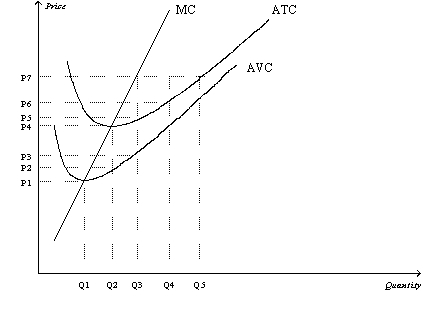A) fixed costs.
B) variable costs.
C) total costs.
D) The firm must pay all its costs, even if it shuts down.
F) B) and D)
Correct Answer

verified
Correct Answer
verified
Multiple Choice
Profit-maximizing firms enter a competitive market when existing firms in that market have
A) total revenues that exceed fixed costs.
B) total revenues that exceed total variable costs.
C) average total costs that exceed average revenue.
D) average total costs less than market price.
F) A) and B)
Correct Answer

verified
Correct Answer
verified
Multiple Choice
Free entry means that
A) the government pays any entry costs for individual firms.
B) no legal barriers prevent a firm from entering an industry.
C) a firm's marginal cost is zero.
D) a firm has no fixed costs in the short run.
F) B) and C)
Correct Answer

verified
Correct Answer
verified
Multiple Choice
Which of the following statements regarding a competitive market is not correct?
A) There are many buyers and many sellers in the market.
B) Firms can freely enter or exit the market.
C) Price equals average revenue.
D) Price exceeds marginal revenue.
F) None of the above
Correct Answer

verified
Correct Answer
verified
Multiple Choice
In a long-run equilibrium,the marginal firm has
A) price equal to average total cost.
B) total revenue equal to total cost.
C) economic profit equal to zero.
D) All of the above are correct.
F) B) and C)
Correct Answer

verified
Correct Answer
verified
Multiple Choice
If a competitive firm is selling 1,000 units of its product at a price of $9 per unit and earning a positive profit,then
A) its total cost is less than $9,000.
B) its marginal revenue is less than $9.
C) its average revenue is greater than $9.
D) the firm cannot be a competitive firm because competitive firms cannot earn positive profits.
F) B) and D)
Correct Answer

verified
Correct Answer
verified
Multiple Choice
The Doris Dairy Farm sells milk to a dairy broker in Prairie du Chien,Wisconsin.Because the market for milk is generally considered to be competitive,the Doris Dairy Farm does not choose the
A) quantity of milk to produce.
B) price at which it sells its milk.
C) profits it earns.
D) All of the above are correct.
F) C) and D)
Correct Answer

verified
Correct Answer
verified
Multiple Choice
Which of these types of costs can be ignored when an individual or a firm is making decisions?
A) sunk costs
B) marginal costs
C) variable costs
D) opportunity costs
F) B) and C)
Correct Answer

verified
Correct Answer
verified
Multiple Choice
When entry and exit behavior of firms in an industry does not affect a firm's cost structure,
A) the long-run market supply curve must be horizontal.
B) the long-run market supply curve must be upward-sloping.
C) the long-run market supply curve must be downward-sloping.
D) we do not have sufficient information to determine the shape of the long-run market supply curve.
F) B) and D)
Correct Answer

verified
Correct Answer
verified
Multiple Choice
A firm in a competitive market has the following cost structure:  If the firm's fixed cost of production is $3,and the market price is $10,how many units should the firm produce to maximize profit?
If the firm's fixed cost of production is $3,and the market price is $10,how many units should the firm produce to maximize profit?
A) 1 unit
B) 2 units
C) 3 units
D) 4 units
F) A) and C)
Correct Answer

verified
Correct Answer
verified
True/False
For a firm operating in a perfectly competitive industry,total revenue,marginal revenue,and average revenue are all equal.
B) False
Correct Answer

verified
Correct Answer
verified
Multiple Choice
Scenario 14-3 Suppose a certain competitive firm is producing Q=500 units of output. The marginal cost of the 500th unit is $17, and the average total cost of producing 500 units is $12. The firm sells its output for $20. -Refer to Scenario 14-3.At Q=499,the firm's total costs equal
A) $5,983.
B) $5,988.
C) $5,995.
D) $5,999.
F) B) and D)
Correct Answer

verified
Correct Answer
verified
Multiple Choice
Regardless of the cost structure of firms in a competitive market,in the long run
A) firms will experience rising demand for their products.
B) the marginal firm will earn zero economic profit.
C) firms will experience a less competitive market environment.
D) exit and entry is likely to lead to a horizontal long-run supply curve.
F) None of the above
Correct Answer

verified
Correct Answer
verified
Multiple Choice
Suppose a competitive market has a horizontal long-run supply curve and is in long-run equilibrium.If demand decreases,we can be certain that in the short-run,
A) at least some firms will shut down.
B) price will fall below marginal cost for some firms.
C) price will fall below average total cost for some firms.
D) at least some firms will enter the industry.
F) All of the above
Correct Answer

verified
Correct Answer
verified
True/False
A firm operating in a perfectly competitive industry will continue to operate if it earns zero economic profits because it is likely to be earning positive accounting profits.
B) False
Correct Answer

verified
Correct Answer
verified
Multiple Choice
In the short-run,a firm's supply curve is equal to the
A) marginal cost curve above its average variable cost curve.
B) marginal cost curve above its average total cost curve.
C) average variable cost curve above its marginal cost curve.
D) average total cost curve above its marginal cost curve.
F) All of the above
Correct Answer

verified
Correct Answer
verified
Multiple Choice
In a competitive market with identical firms,
A) an increase in demand in the short run will result in a new price above the minimum of average total cost, allowing firms to earn a positive economic profit in both the short run and the long run.
B) firms cannot earn positive economic profit in either the short run or long run.
C) firms can earn positive economic profit in the long run if the long-run market supply curve is upward sloping.
D) free entry and exit into the market requires that firms earn zero economic profit in the long run even though they may be able to earn positive economic profit in the short run.
F) A) and D)
Correct Answer

verified
Correct Answer
verified
Multiple Choice
Table 14-8
Suppose that a firm in a competitive market faces the following revenues and costs:
 -Refer to Table 14-8.The firm will not produce an output level beyond
-Refer to Table 14-8.The firm will not produce an output level beyond
A) 4 units.
B) 5 units.
C) 6 units.
D) 7 units.
F) A) and B)
Correct Answer

verified
Correct Answer
verified
Multiple Choice
When firms in a perfectly competitive market face the same costs,in the long run they must be operating
A) under diseconomies of scale.
B) with small, but positive, levels of profit.
C) at their efficient scale.
D) where price is equal to average fixed cost.
F) A) and D)
Correct Answer

verified
Correct Answer
verified
Multiple Choice
Figure 14-5
Suppose a firm operating in a competitive market has the following cost curves:
 -Refer to Figure 14-5.In the short run,if the market price is higher than P4 but less than P6,individual firms in a competitive industry will earn
-Refer to Figure 14-5.In the short run,if the market price is higher than P4 but less than P6,individual firms in a competitive industry will earn
A) positive profits.
B) zero profits.
C) losses but will remain in business.
D) losses and will shut down.
F) A) and B)
Correct Answer

verified
Correct Answer
verified
Showing 321 - 340 of 478
Related Exams